#19th-early 20th century american art
Text

Francis Davis Millet (American, 1848-1912) • Room Interior with Winding Staircase • Between 1846 and 1912 • Smithsonian Museum of American Art
Interesting fact: Francis Millet was among the passengers who perished on the Titanic in 1912.
#art#fine art#painting#art history#paintings of interiors#francis davis millet#paintings of domestic interiors#american artist#american painter#oil painting#19th-early 20th century american art#the painted room art blog#art blogs on tumblr#art blogs
87 notes
·
View notes
Text
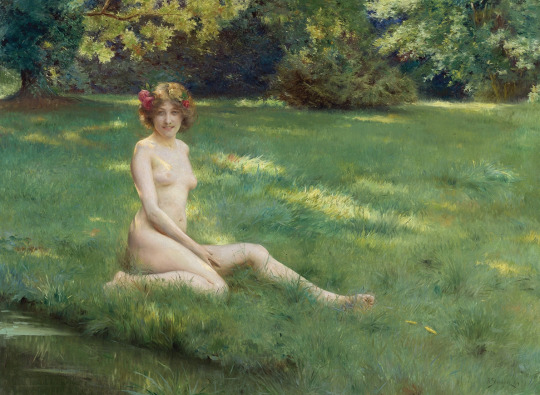
Un Nu Sur La Pelouse, 1899
Julius Leblanc Stewart
#Julius Leblanc Stewart#american art#art#painting#art history#belle epoque#early 20th century#nature#idyllic#summer#the girls#1890s#19th century
376 notes
·
View notes
Text

William Mcgregor Paxton (1869–1941) • La Russe (The Russian) • By 1913
#art#painting#fine art#art history#pagan sphinx art blog#women in paintings#portrait#unidentified portrait#female portrait#oil painting#boston school#american impressionism#american artist#late 19th to early 20th century american art#art lovers on tumblr#history of art#art blogs on tumblr#art appreciation
117 notes
·
View notes
Text

Cecilia Beaux (American, 1855-1942) • Dorothea and Francesca • 1898 • Art Institute of Chicago
#women in white#art#cecilia beaux#woman painter#la robe blanche#painting#white dress#women in paintings#fine art#portrait#american artist#late 19th to early 20th century art
43 notes
·
View notes
Text
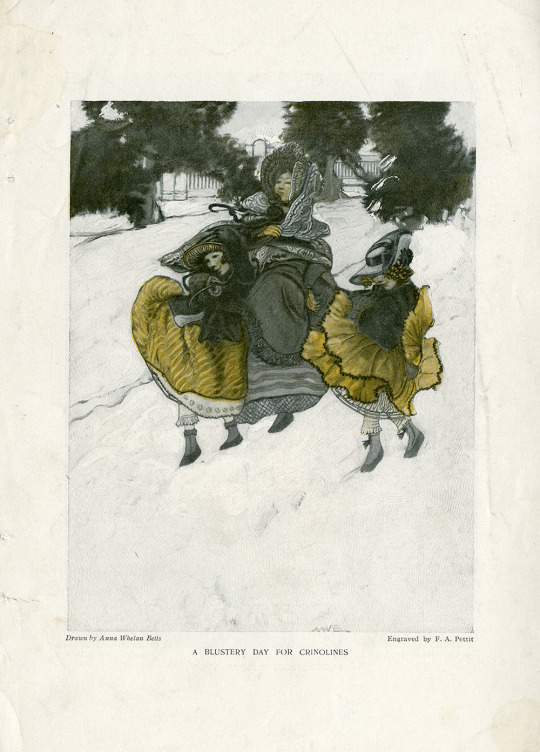
Anna Whelan Betts (American illustrator, 1873-1959 • A Blustery Day for Crinolines • Unknown publication • Engraving by F.A. Pettit.
#illustration#art#illustrator#anna whelan betts#american illustrator#woman illustrator#engraving#late 19th to early 20th century illustration#sassafras and moonshine blog#vintage illustration#whimsical illustration
9 notes
·
View notes
Text
I don't know if you're ready for this BUT American Duchess and the Bata Shoe Museum just launched a collab collection called In Bloom.
They made 3 styles in several colours using 3 styles from the the 18th, 19th and 20th centuries from their current exhibition "In Bloom: Flowers and Footwear", and are currently in pre-sale, with estimated deliveries between July and August 2023.
Let's take a look:
We start at the 18th century with the Primrose shoes, based on their Dunmore model, accurate for 1770s-1790s they are embroidered on satin and are $179 USD while in pre-sale and later will be $199. The original style is in black and pink silk satin, and OF COURSE that's my favourite variation, but the green ones are a close second.



Images from top: 1780s shoes, Bata Shoe Museum / Primrose shoes, American Duchess.
From the 19th century we have this style called Flora, accurate for the late 19th century (1870s-1900), are $230 USD while in pre-sale and later will bee $250. This embroidered boots with satin ribbon laces are probably my favourite style from the collection. Of course my fave colour is black, which is also the colour of the original piece, but the lavender ones are just *chef kiss*:
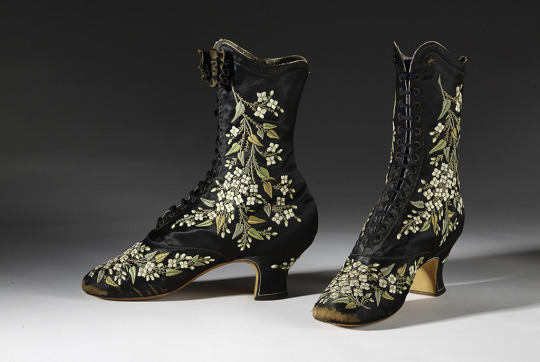


Images from top: the original French embroidered boots by Francois Pinet, late 1870s-early 1880s, Bata Shoe Museum. / Flora boots, American Duchess
Finally, the 20th century style is the Daisy, accurate for the 1920s-1940s. A vintage style full of flowers and colour, this T-strap style is perfect to pair with a simple dress from any decade and have a very decent 6.3cm heel, so you can dance all night in these art deco shoes.
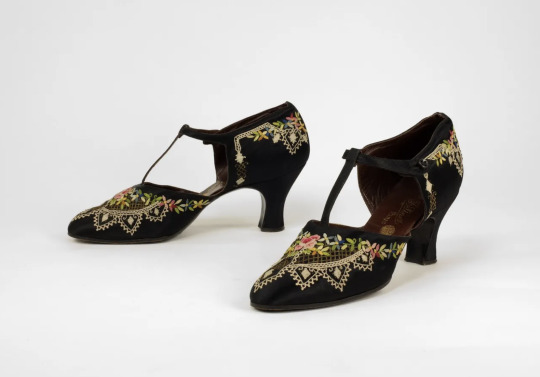
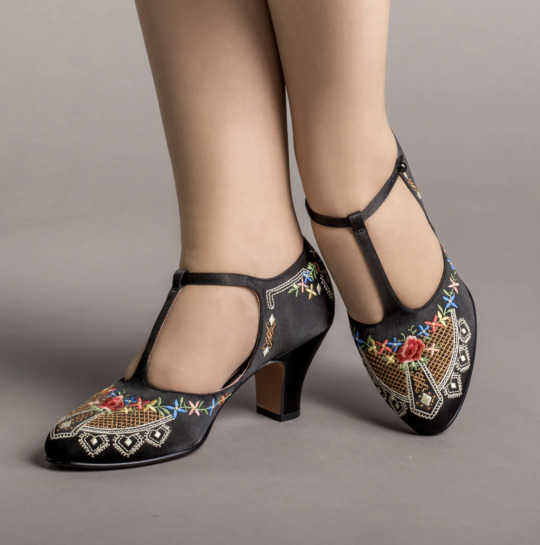
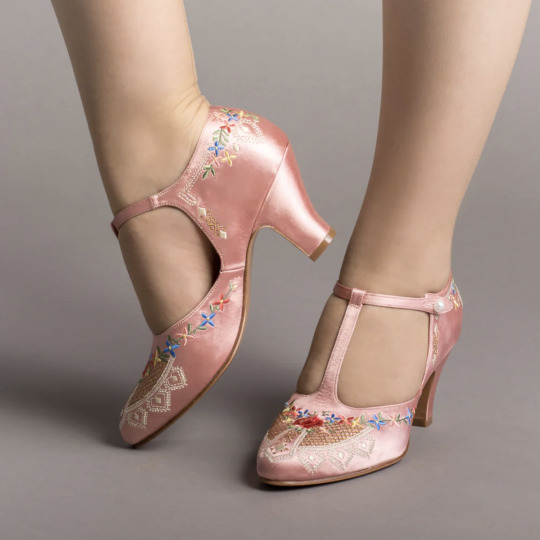
1920s shoes, Bata Shoe Museum / Daisy shoes, American Duchess.
The sales from the In Bloom collection will support The Bata Shoe Museum in their study, outreach, and conservation of historic footwear, and we're here for it.
More info:
"In Bloom: Flowers and Footwear"
Read more about the collaboration at the American Duchess Blog.
Buy the whole collection in pre-sale here.
Which style are you looking for the most?
#shoes#accessories#in bloom#florals#18th century#19th century#20th century#historical shoes#american duchess
8K notes
·
View notes
Text




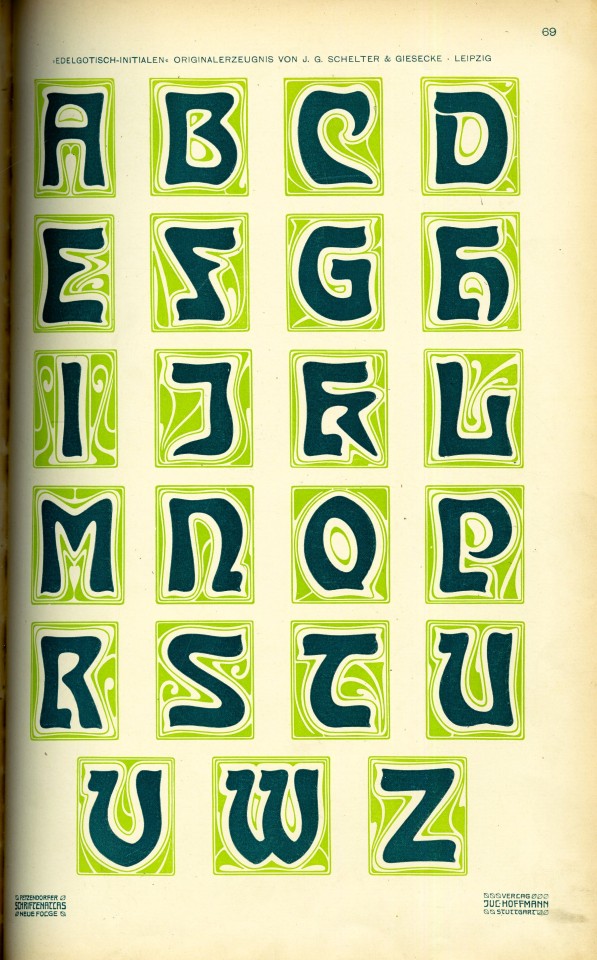
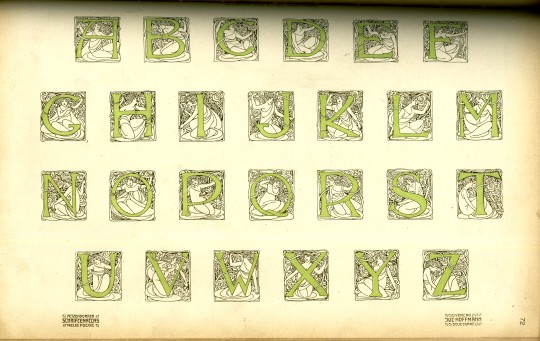


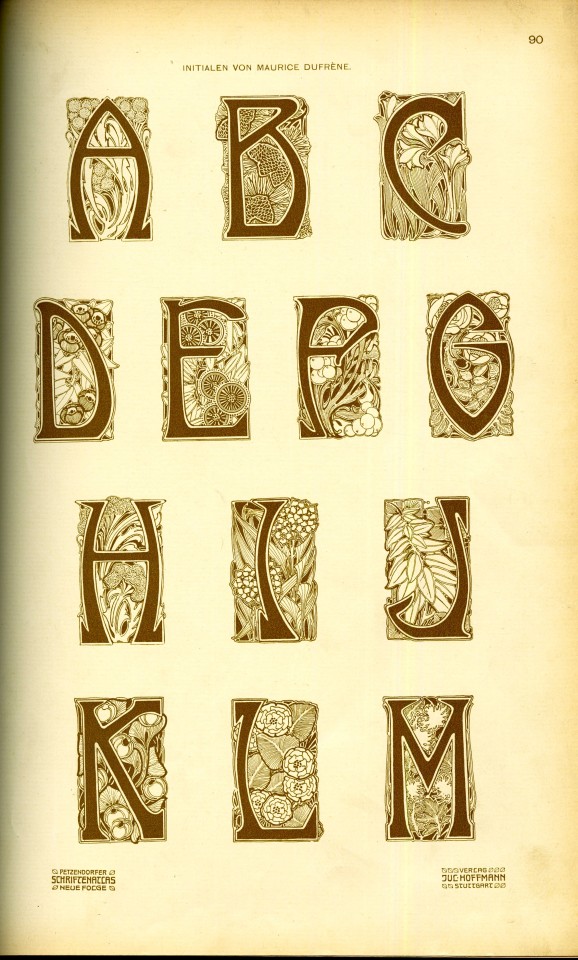

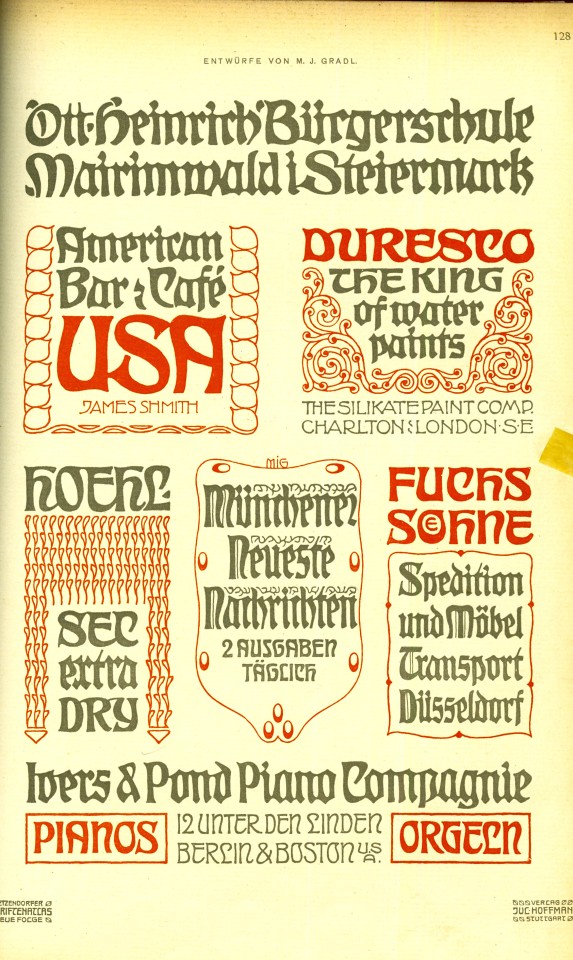
Typography Tuesday
Last month, the Milwaukee Public Library's Arts & Media Department held its first Art Book Club session. Intended as an informal art book appreciation club that meets once a month in the Art, Music, and Recreation room, each session explores a different theme by looking at the wide variety of art materials in the collection. The collection is historical, non-circulating, and vast. I attended and spent an hour and a half mesmerized by the array of luscious materials presented.
There was design, architecture, fashion, and much more. As a type nerd, I was especially drawn to the several late 19th- and early 20th-century type specimen books on the tables. Here, for example, are some pages of chromatic initials by various European and American companies from Schriften Atlas, compiled by Ludwig Petzendorfer and published in Stuttgart by Julius Hoffmann in 1898.
MPL held its second Art Book Club session on the theme of "Animals" last night, but I missed it because I was conducting an evening instruction session. Dang! But I'll be attending future sessions when I can and I'll keep y'all apprised.
View other type specimen books.
View more Typography Tuesday posts.
-- MAX, Head, Special Collections
#Typography Tuesday#typetuesday#chromatic type#type specimen books#type specimens#initials#type display books#Schriften Atlas#Ludwig Petzendorfer#Julius Hoffmann#Milwaukee Public Library#Art Book Club#19th century type
325 notes
·
View notes
Text
Rewind the Tape —Episode 1
Art of the episode
During our rewatch, we took note of the art shown and mentioned in the pilot, and we wanted to share. Did we miss any? Do you have any thoughts about how these references could be interpreted? How do you think Armand and Louis go about picking the art for their penthouse in Dubai?

The Fall of the Rebel Angels
Peter Bruegel the Elder, 1562
This painting is featured in the Interview with the Vampire book, and it was important enough to be included in the draft pilot script!

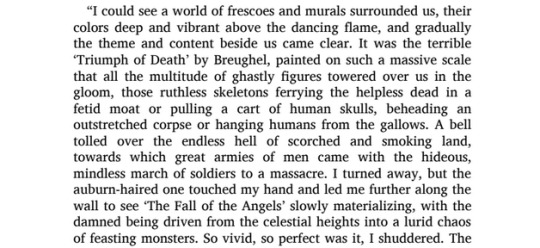
Bruegel the Elder was among the most significant Dutch and Flemish Renaissance artists. He was a painter and print-maker, known for his landscapes and peasant scenes.

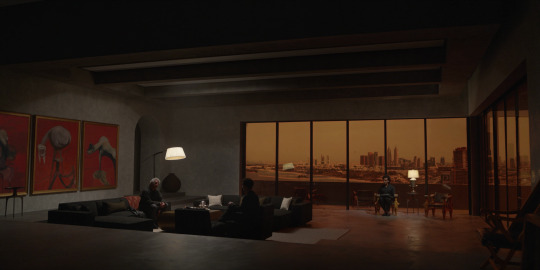

Three Studies for Figures at the Base of a Crucifixion
Francis Bacon, 1944
Bacon was an Irish figurative painter, known for his raw, unsettling imagery and a number of triptychs and diptychs among his work. At a time when being gay was a criminal offense, Bacon was open about his sexuality, and was cast out by his family at 16 for this reason. He destroyed many of his early works, but about 590 still survive.
The Tate, where these paintings are displayed, says this about the work: "Francis Bacon titled this work after the figures often featured in Christian paintings witnessing the death of Jesus. But he said the creatures represented the avenging Furies from Greek mythology. The Furies punish those who go against the natural order. In Aeschylus’s tragedy The Eumenides, for example, they pursue a man who has murdered his mother. Bacon first exhibited this painting in April 1945, towards the end of the Second World War. For some, it reflects the horror of the war and the Holocaust in a world lacking guiding principles."


Strawberries and Cream
Raphaelle Peale, 1816
Peale is considered to have been the first professional American painter of still-life. [Identified by @diasdelfuego.]

Outfits inspired by J.C. Leyendecker
Leyendecker was one of the most prominent and commercially successful freelance artists in the U.S. He studied in France, and was a pioneer of the Art Deco illustration.
Leyendecker's model, Charles Beach, was also his lover of five decades. You can read costume designer Carol Cutshall's thoughts on these outfits on her Instagram.
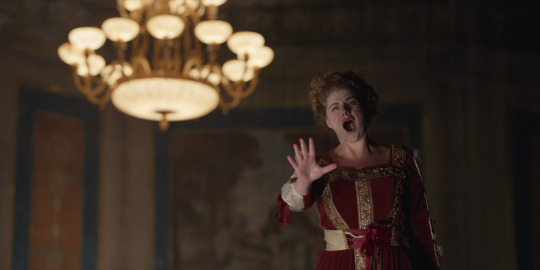
Iolanta
Pyotr Tchaikovsky, 1892
The opera Louis and Lestat go to was composed by Tchaikovsky, another gay artist. The play tells a story "in which love prevails, light shines for all, lies are no longer necessary and no one must fear punishment," as put by Susanne Stähr for the Berliner Philharmoniker.

On the Hunt or Captain Percy Williams On A Favorite Irish Hunter
Samuel Sidney, 1881
The unidentified painting on the right might be from the same hunting series, though we couldn't identify the exact one. There's also a taxidermy deer, ram, and piebald deer on the wall. [Identified by @vfevermillion.]

The Artist's Sister, Melanie
Egon Schiele, 1908
Schiele was an Austrian expressionist painter and protege of Gustav Klimt. Many of his portraits (self portraits and of others) were described as grotesque and disturbing. [Identified by @dwreader.]
A Stag at Sharkey's
George Wesley Bellows, 1909
Bellows was an American realist painter, known for his bold depictions of urban life in New York City. [Identified by @vfevermillion.]

Mildred-O Hat
Robert Henri, undated (likely 1890s)
Henri was an American painter who studied in Paris, where he learned from the Impressionists and determined to lead an even more dramatic revolt against American academic art. [Identified by @nicodelenfent, here.]
Starry night
Edvard Munch, 1893
Munch was a Norwegian painter, one of the best known figures of late 19th-century Symbolism and a great influence in German Expressionism in the early 20th century. His work dealt with psychological themes, and he personally struggled with mental illness. [Identified by @vfevermillion.]
If you spot or put a name to any other references, let us know if you'd like us to add them with credit to the post!
Starting tonight, we will be rewatching and discussing Episode 2, ...After the Phantoms of Your Former Self. We hope to see you there!
And, if you're just getting caught up, learn all about our group rewatch here ►
#louis de pointe du lac#daniel molloy#lestat de lioncourt#vampterview#interview with the vampire#iwtv#amc interview with the vampire#interview with the vampire amc#amc iwtv#iwtv amc#IWTVfanevents#rewind the tape#in throes of increasing wonder#analysis and meta#art of the episode
65 notes
·
View notes
Note
i saw your tag about how in 500 years we WON'T be calling britney spears' "toxic" classical music, and i am willing and able to hear this rant if you so wish to expand upon it :3c
You know what, it's been over six months, so sure, why not, let's pick today to have this rant/lesson!
To establish my credentials for those unfamiliar Hi my name's Taylor I was a music teacher up until last year when the crushing realities of the American Education SystemTM led me to quit classroom work and become a library clerk instead. But said music teaching means that I have 4+ years of professional classical training in performance and education, and while I'm by no means a historian, I know my way around the history of (european) music.
So, now that you know that I'm not just some rando, but a musical rando, let me tell you why we won't be calling Britney Spears or [insert modern musician(s) that'd be especially humorous to today's audience to call classical] "classical music."
The simple answer is that "Old music =/= Classical music," which is usually the joke being made when you see this joke in the first place.
youtube
As funny as this joke can be when executed well (this is one of my favorite versions of said joke, especially since this is a future world where there's very little accurate surviving info about the culture from the 21st century), there is VERY little likely of this actually being how music from today is referred to in the future, because, again, music being OLD does not automatically make music CLASSICAL.
If you'd indulge me a moment, have a look at these three pieces from the early 1900s, which is now over 100 years ago. That's pretty old! You don't have to listen to the whole of all of them if you don't want to, but give each around 30 seconds or so of listening.
youtube
youtube
youtube
All three pieces are over 100 years old, but would you call "In the Shade of the Old Apple Tree" classical? Or "The Entertainer?" Most likely not. You'd probably call these songs "old timey" and you may even be savvy enough to call "The Entertainer" by it's actual genre name, ragtime. But if either of these songs came on the radio, you wouldn't really call them classical, would you? They're just old.
Whereas Mahler's Symphony No. 5, now that sounds like classical music to you, doesn't it? It's got trumpets, violins, a conductor, it's being played by a philharmonic! That's a classical musicy word!
The short answer of why we in the real, nonfictional world won't be calling Britney Spears's "Toxic" classical music in 100 years is it simply doesn't sound like classical music.
.....and the long answer is that Mahler's Symphony No. 5 isn't actually classical either.

See, music, just like everything in culture from dress to art to architecture changed with the times, and therefore 'classical music' is technically (although not colloquially) only one of about four to five musical periods/styles you're likely to hear on one of those "classical music tunes to study to" playlists.
Our dear friend Mahler up there was not a classical composer, he was a composer of the late romantic era.
So now, because I have you hostage in my post (just kidding please don't scroll away I had a lot of fun writing this but it took me nearly 3 hours) I'm going to show you the difference between Classical music and the other musical eras.
These are the movements we'll be dealing with, along with the general dates that define them (remembering of course that history is complicated and the Baroque Period didn't magically begin on January 1st, 1600, or end the moment Bach died) :
The Baroque Period (1600-1750)
The Classical Period (1750-1820)
The Romantic Period (1820-1910)
The Impressionist Movement (1890-1920)
You'll notice that as time goes on, the periods themselves grow shorter, and there starts to become some overlap in the late 19th to early 20th century. The world was moving faster, changing faster, and music and art began changing faster as well. Around the beginning of the 20th century music historians quit assigning One Major style to an entire era of history and just started studying those movements themselves, especially since around the 20th century we were getting much more experimentation and unique ideas being explored in the mainstream.
Even the end of the classical to the beginning of the romantic period can get kind of fuzzy, with Beethoven, arguably one of the most famous classical (and yes he was actually classical) composers in history toeing the line between classical and romantic in his later years. The final movement of his 9th symphony, known as Ode to Joy, far more resembles a romantic work than a classical one.
But, I'm getting ahead of myself.
To oversimplify somewhat, here are the main characteristics of said movements:
The Baroque Period (1600-1750)
Music was very technical and heavily ornamented. This coincided with a very "fancy" style of dress and decoration (the rococo style became popular towards the latter half of this period). The orchestras were far smaller than we are used to seeing in concert halls today, and many instruments we consider essential would not have been present, such as the french horn, a substantial percussion section, or even the piano*. Notable composers include Vivaldi (of the Four Seasons fame), Handel (of the Messiah fame) and Bach:
youtube
*the piano as we know it today, initially called the pianoforte due to its ability to play both softly (piano) and loudly (forte) in contrast to the harpsichord, which could only play at one dynamic level, was actually invented around 1700, but didn't initially gain popularity until much later. This Bach Concerto would have traditionally been played on a harpsichord rather than a piano, but the piano really does have such a far greater expressive ability that unless a group is going for Historical Accuracy, you'll usually see a piano used in performances of baroque work today.
The Classical Period (1750-1820)
In the classical period, music became more "ordered," not just metaphorically but literally. The music was carefully structured, phrases balanced evenly in a sort of call and response manner. Think of twinkle twinkle little star's extremely balanced phrasing, itself a tune that Mozart took and applied 12 classical variations to, cementing it in popularity.
And speaking of twinkle twinkle, memorable melody became more important to the composition than ornamentation, and many of our most universally known melodies in the west come from this period. The orchestra also grew bigger, adding more players of all kinds as now we didn't have to worry about overpowering the single-volume harpsichord, and additional instruments like more brass and woodwinds were added. Notable composers include Haydn (of The Surprise Symphony fame) Beethoven (of, well, Fame), and Mozart:
youtube
Pay attention to the size of the orchestra here, then go back to the Bach concerto. Notice how in that very typical Baroque setting, the orchestra sits at maybe 20 people, and that here in a Classical setting, there's nearly two times that!
The Romantic Period (1820-1910)
In the romantic period, it was all about BIG FEELINGS, MAN. It was about the DRAMA. Orchestras got even bigger than before, the music focused less on balance and became more dramatic, and there was a big focus on emotions, individualism, and nationalism. Discerning listeners will notice a lot of similarities between romantic symphonies and modern film scores; John Williams in particular is very clearly influenced by this era, any time I'd play the famous Ride of the Valkyries by Wagner in a class, the kids would remark that it sounds like it should be in Star Wars.
A lot of romantic composers were German, including Beethoven, if you want to call his later works romantic (which I and many others argue you can, again, compare Ode to Joy to one of his earlier works and you can hear and see the difference), but you also have the Hungarian Liszt (of the Hungarian Rhapsodies fame), the Russian Tchaikovsky (of the Nutcracker and 1812 Overture fame), and the Czech Dvořák:
youtube
See how this orchestra is even bigger still? Modern orchestras tend to vary in size depending on what pieces they are playing, but the standard is much closer to this large, romantic size, and it's far less typical to see a small, intimate Baroque setting unless specifically attending a Baroque focused concert.
Also I know I embedded Dvořák because Symphony From a New World slaps but please also listen to Liszt's Hungarian Rhapsody No.2 it's one of my all time favorite pieces and NOT just because of the Tom and Jerry cartoon, alright? Alright.
The Impressionist Movement (1890-1920)
A bit after it began but definitely still during the romantic period, a counter movement began in France that turned away from the emotional excess of romanticism and focused less on standard chord progression and explored more unconventional scales. This music was less worried about how it 'should' sound and was more concerned with evoking a certain emotion or image, giving you an "impression" of an idea. Debussy is by far the most well known name in this movement, even though he personally hated the term 'impressionism,' lol.
youtube
Notice the way the periods build on each other naturally, literally, physically builds on the orchestras that came before, evolving in style and structure until you get to the late 19th and early 20th century when things were built up so big that a response to that excess started to develop, first in the impressionist movement, and then into 20th century music in general, which got much more experimental and, as we say, "weird." (frickin 12 tone scales, man)*
*i do not actually dislike the sound of 12 tone, it's interesting and unique, but it is HELL to analyze in music theory, which is unfortunately when a lot of us classical musicians are first introduced to it, therefore tarnishing our relationship to the genre as we cannot separate it from our own undergrad anguish
Even if you're not a super active listener and you have a harder time discerning the difference between, say, late baroque and early classical, you cannot deny that the first piece I've linked by Bach and the last piece I've linked by Debussy sound completely different. They're both orchestral pieces (I intentionally chose all orchestral pieces as my examples here, getting into solo works, opera, and chamber ensembles would take too long), but other than that, they couldn't be more different.
Wait, so what are we talking about again?
Classical Music is first a period of music, a specific artistic movement with music typically written in Europe between 1750 and 1820 with a specific sound that is distinct from these other styles I've outlined here.
And Classical Music is second a genre. Because while academically and historically Baroque music is not classical, and Romantic music is not classical...colloquially it is. They sound similar enough that it makes sense to put them on the same playlists, the same radio stations, the same 'beats to study to' youtube compilation videos. While individuals may have favorites and preferences, it's not far fetched to say that if you like listening to one of these styles, you'll at least like one of the others.
But whether you're being broad and referring to our modern idea of the classical genre, or you're being pedantic like me and referring to a specific period of musical history (or modern compositions emulating that style, because yeah, modern compositions of all of theses styles do exist), I think we can all agree that, as much as it slaps, "Toxic" by Britney Spears is not classical music, and 500 years is unlikely to change our perspective of that.
A Traditional Ballad though?
Yeah, I can see us calling it that in 5 billion years.
youtube
(the full version of this scene is age restricted for some reason, but you can watch it here)
Anyway, thanks for reading y'all, have a good one!
#music#music theory#music history#classical music#baroque music#romantic music#impressionist music#music teacher#music teaching#taylor teaches#asks and answers#long post
181 notes
·
View notes
Text
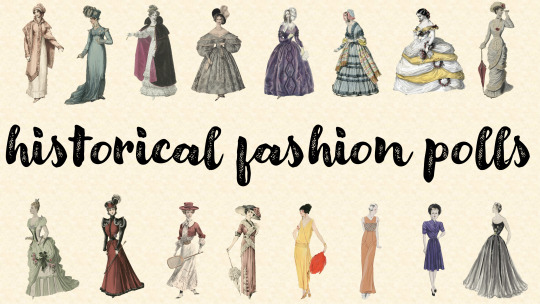
hello and welcome to historical fashion polls!
i'm so glad you're here and i hope you enjoy your stay 🥰
here (below the cut) you'll find all the relevant info related to the blog:
about the blog and the curator
image submission
requests
never hesitate to send in a message if you have questions, comments, or just want to say hi ☺️

this blog is dedicated to historical fashion polls!
currently, i limit myself to fashion plates, catalogue images, and other mass-produced fashion illustrations (explanation here)
the main timespan covered by the blog is 1770-1990 (explanation here)
however, i am happy to receive image submissions from outside these parameters – more info on making requests and submitting images below!
discussions about what content will be featured on the blog can be found under the tag "curatorial updates"
relevant decades and centuries are tagged on all posts

my name is charlotte (she/they) and i'm the curator of the blog! ☺️
i'm an art history phd student and aspiring professor studying late 19th century british and american art, primarily ephemera and "visual culture" (like fashion plates, book and newspaper illustrations, scrapbooks, photographs, etc.)
my main blog (where i talk about art history and music and make edits) is @ourstaturestouchtheskies
my ramblings can be found under the tag "the curator speaks"
my lovely conversations with all of you can be found under the tag "curatorial correspondences"

i'm very happy to receive image submissions from you all!
you can do that through the ask box, by submitting a post, or via direct message
image submission requirements (without these i won't be able to feature your image 😔😔)
please include the year or decade the image represents
please ensure that we can see the clothing clearly enough to get a sense of what each garment looks like
since this is a poll blog, please be sure that the garments chosen are at least somewhat comparable
if sending in images via dm, let me know whether you would like me to tag you in the post that features your image
as always, feel free to let me know if you have questions on any of these requirements! ☺️

i'm also very happy to take requests!
if you have something specific you'd like to see featured on the blog, send me an ask!
please just remember that the kinds of images i myself will source are primarily from fashion plates that span from 1770-1990 (more detailed info available above)
if your request is outside these parameters, i encourage you to submit the images you'd like to see featured! (more detailed info available above)
to give a sense of the kinds of things that folks have requested, both pending and resolved requests are available below

requests that i have received but for which i have not yet been able to add images to the queue
footwear
lower-middle class fashion
40s skiwear
late 19th c artistic/aesthetic dresses
historical sleepwear/nightgowns
armor?

requests that i have received and have either already been featured on the blog or are currently in the queue
masc fashion (late 18th c, early-mid 19th c, early-mid 20th c)
bloomers
headgear
swimwear
80s prom/bridesmaid dresses
20s tennis outfits
40s/50s pjs
#finally made a comprehensive intro post!!#historical fashion polls#the curator speaks#curatorial updates#long post#intro post
35 notes
·
View notes
Text

AMERICAN FOLK ART DOG PICTORIAL HOOKED RUG, square form, depicting a reclining dog in the center, surrounded by dark-colored field. Mounted to fabric on a wooden stretcher for hanging. Late 19th/early 20th century.
Jeffrey Evans
424 notes
·
View notes
Text
Knives for Commoners
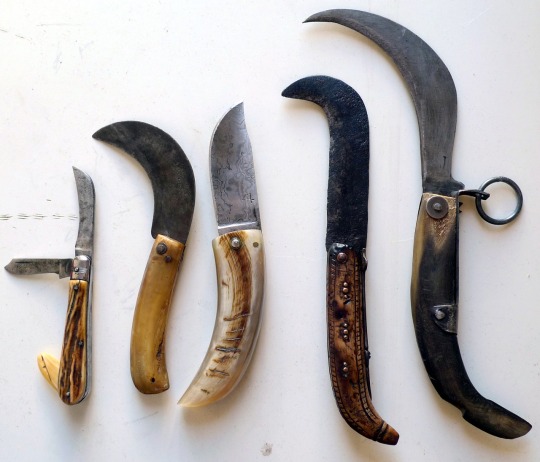
Precious daggers are cool and all, but I’m very fond of simple pocket knives, made to get shit done. So here are a few farmer / peasant knives, ranging from penknife- to sickle-sized.
1. Grafting knife (greffoir) from Thiers, France

This little multi-tool has a curved blade (very used and sharpened, it was originally wider) and a smaller wavy blade. It’s primarily for cutting the stock plant and the plant shoot (or bud) that you mean to graft, though it’s also good for small pruning jobs and general utility. It locks by slipjoint, the standard pocket knife locking mechanism that you’ll find in Swiss army knives. The small flat thing is a bark lifter, it’s made of bone and it’s used for bud grafting: when you insert a bud beneath the bark of a stem, you have to be extra careful to not injure the bark, so you don’t want sharp edges there.
The handle has scales of bone, carved like this in order to look like stag (which is rarer and more expensive). A similar way to accomplish this is “jigged bone” scales, found in a lot of old/classic American and English knives:
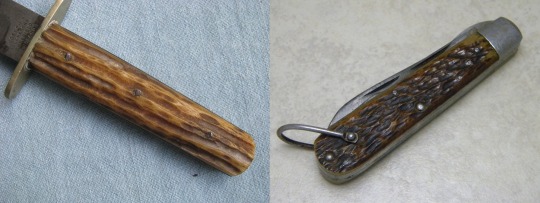
Sheffield hunting knife by Joseph Allen / American folding knife by Camillus
which I honestly think is too... regular, sometimes it looks machine-made even when it’s handmade. But this handle here is sculpted, it’s a work of art, I love it.
Manufactured sometime in *waves vaguely* the 20th century (probably 1930s-1960s) by the cutlery A. Bardin-Dozolmé. The blade is stamped “57 BARDIN Garanti”, which tells us nothing useful, this stamp’s been around since the 18th century. It’s 9.2 cm closed and 14.7 cm open. (3.62 / 5.79 inches)
2. Pruning knife (trinxet) from Mallorca, Spain
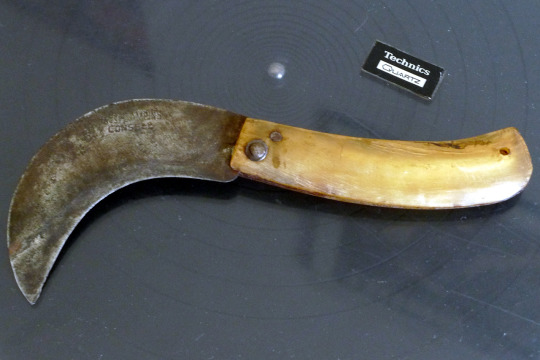
I’ve shown you this before, it’s got a curved carbon steel blade, a horn handle, and “friction lock” as they call it nowadays i.e. no lock whatsoever, it’s a clasp knife. And it’s the simplest, most convenient tool, I adore it.
Made by the cutlery Hermanos Campins in Consell, Mallorca, stamped “HNOS CAMPINS / CONSELL”, mid-20th century, 9.7 cm closed and 17 cm open. (3.82 / 6.7 inches)
3. Shepherd knife (couteau de berger) from Corsica, France
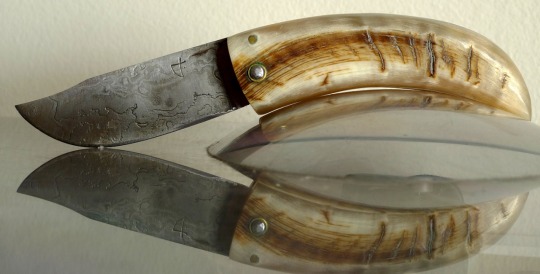
Another clasp knife (doesn’t lock), different shape, with a ram horn handle. Shepherd knives look like utility or bushcraft knives, their blades are not usually curved but they often have a clip-point shape, and they’re quite sturdy.
This is an outlier, it wasn’t really made for work, it’s for tourists or collectors. However, it’s handmade in the tradition of Corsican knife-making (as opposed to the more famous vendetta knives which were manufactured in mainland France, though I should clarify this shape isn’t uniquely Corsican either, it was widespread in both France and Italy), with a couple of modern touches: the blade is forged with a decorative flair, and the horn is first carved at the ridges (to emphasise it’s ram, I’m guessing) and then polished like a mirror.
It’s a strong, solid knife, and absolutely gorgeous.
Made by a local knife-maker (unfortunately I don’t know the name, the blade is signed but with a symbol) in Sartène, Corsica, maybe a decade ago. 11.5 cm closed and 19 cm open. (4.53 / 7.48 inches)
4. Folding billhook (roncola) from Italy


Billhooks are farming tools for cutting and pruning, though usually they have fixed blades. This one isn’t just folding, it’s an actual picklock, like a switchblade. (I mean with the same locking mechanism, it doesn’t open automatically or anything). The blade is carbon steel (that’s a lot of carbon, folks!) and the handle is beautiful, made of carved wood, with brass (I think) insets, and with a fancy external backspring.
Folding billhooks were exported from Italy to the UK. From 1961, a lot of them were imported by Whitby Knives, stamped “Whitby”, and were made in Maniago by Mauro Mario, a prolific knife-maker who also made a ton of switchblades. They looked like this:

The one I got looks earlier to me, but honestly I have no idea when it’s from. Early 20th? Late 19th? *uncertain noises* In any case, it’s 12 cm closed and 22.5 cm open. (4.72 / 8.86 inches)
5. Huge pruning knife (saca tripas) from Guanajuato, Mexico

And last but not least, a big fuck-off pruning knife, which locks securely with a ratchet and unlocks with a pull-ring. This is basically a folding sickle, you reap stuff with it, and can cut thick branches. The very curved carbon blade (it’s not over-sharpened, that’s its original shape) is stamped with a “J”, and the handle is made of horn, with an iron backspring.
The name is extravagantly bloodthirsty, it means “disemboweller” (saca tripas = “pulls out intestines”), and is of course a misnomer: this isn’t a weapon, it’s a farming tool. (Could it be used as a weapon? Well of course, but so can kitchen knives.) I’m not entirely sure if it’s really called that way, or only as a jest, or for the express purpose of selling one of them to bloodthirsty types, i.e. to morons. [Pet peeve: mislabeling work knives as “military” or “fighting” or “tactical”, when they’re clearly for utility, and often for some specific farming job. I even saw an ad for a knife like this describing it as a torture implement, for fuck’s sake people, IT’S FOR CUTTING PLANTS.]
So anyway, these knives can be found all over Mexico, and this one hails from the city of Guanajuato, or at least it was bought there at some point. It’s 16 cm closed and 28.5 cm open. (6.3 / 11.22 inches)
The lot of them
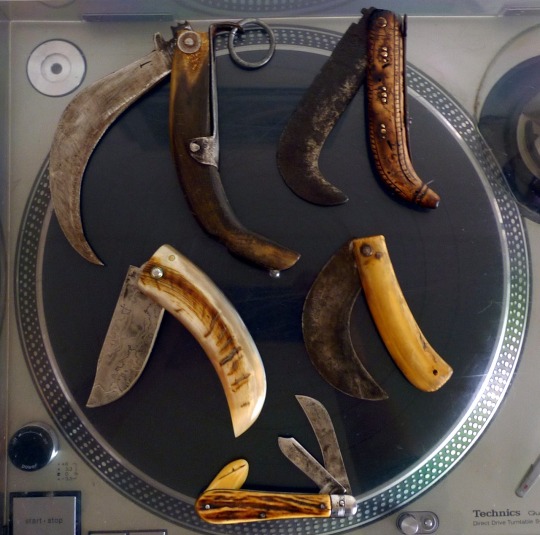
Despite the fact that all these are work knives (except the Corsican, but only technically: it emulates a specific, older work knife, and it’s still 100% functional), a clear effort has been made to make them pretty. And I LOVE this. Even the trinxet, which has a monochrome handle and no frills at all, is elegant in its simplicity, and they all have something going on, carvings, decorations, handles shaped to please the eye, materials chosen for their nice colour.
Aesthetically speaking, I think knives went to shit when plastic was adopted. (Practically speaking, I admit plastic is a lot more resistant to the elements; a handle of horn or bone must be kept dry or it shrivels, wood must be kept from dryness or it shrinks, bugs and mites eat it, it’s a mess.)
Not one blade here is stainless steel, and it shows.
Only the handle of the grafting knife (the smallest one) has scales riveted on a metal frame. Not coincidentally, it’s the most industrial production, it came out of a Thiers factory. (Thiers is a major cutlery centre, like Sheffield and Solingen.) The rest were hand-made in a workshop or at most a cottage industry (a bunch of people in a village construct parts and someone assembles them), and their handles are solid blocks of material (horn or wood), with a slit in the middle to fit the folded blade. That’s the simpler, older construction.
Folding knives are cool.
@tuulikki. And @victoriansword, @petermorwood, @peashooter85, I know you’re into the fancy stuff, but here I am plying humbler wares and hoping. :)
505 notes
·
View notes
Text

Girl In A Japanese Costume
William Merritt Chase
#american art#art#painting#art history#William Merritt Chase#impressionism#early 20th century#1900s#late 19th century#fashion#portrait#lavender#orientalism
173 notes
·
View notes
Text
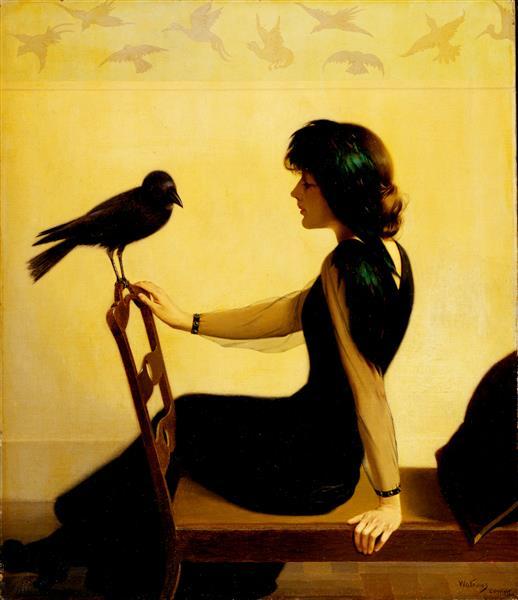
Harry Willson Watrous (American, 1857-1940) ~ The Chatterers ~ 1913 ~ Clark Art Institute - Williamstown, Massachusetts
#art#painting#fine art#art history#women in paintings#19th century art#portrait#american artist#early 20th century art#harry watrous#figural painting#birds in paintings
22 notes
·
View notes
Text
Meadow near 91st and Central Park West

Meadow near 91st and Central Park West
Central Park West, often abbreviated as CPW, is a prominent and prestigious avenue located along the western edge of Central Park in Manhattan, New York City. It is one of the city's most iconic and sought-after residential addresses, known for its historical significance, architectural grandeur, and cultural importance. Here are some key details about Central Park West:
Location: Central Park West runs parallel to Central Park, starting at 59th Street in the south and extending to 110th Street (also known as Cathedral Parkway) in the north. It forms the western boundary of Central Park and offers stunning views of the park's landscape.
Historical Significance: Central Park West is lined with a diverse array of architectural styles and historic buildings, many of which date back to the late 19th and early 20th centuries. It is often considered a showcase of New York City's architectural history.
Architectural Diversity: Along Central Park West, you'll find a mix of architectural styles, including Beaux-Arts, Renaissance Revival, Art Deco, and more. Notable buildings include The Dakota, The San Remo, The Eldorado, and The Beresford, all of which are famous for their architectural splendor and the notable residents who have called them home.
Cultural Institutions: Central Park West is home to several renowned cultural institutions, including the American Museum of Natural History, one of the largest and most prestigious natural history museums in the world. The Museum of Arts and Design (MAD) and the New-York Historical Society are also located along this avenue.
Residential Prestige: Central Park West has long been associated with luxury living. The buildings along this avenue often feature spacious apartments with park views, elegant pre-war details, and a high level of service. Many notable individuals, including celebrities and business moguls, have chosen to reside in this area.
Transportation: Central Park West is well-connected to the rest of Manhattan via public transportation. It is served by several subway lines, including the A, B, C, D, and 1 trains, making it relatively easy to access other parts of the city.
Scenic Beauty: Residents and visitors of Central Park West enjoy breathtaking views of Central Park, with its lush greenery, serene lakes, and iconic landmarks. The proximity to the park provides a sense of tranquility and natural beauty amidst the bustling city.
Cultural and Entertainment Events: Due to its proximity to Central Park and its cultural institutions, Central Park West is often a focal point for cultural and entertainment events, including parades, concerts, and film screenings.
Real Estate: Real estate along Central Park West is highly sought after and can command some of the highest prices in the city. The area is known for its co-op and condominium buildings, each with its own unique character and charm.
Historic Preservation: Many of the buildings along Central Park West are designated as New York City landmarks or are part of historic districts, ensuring their preservation and protection. This commitment to preserving the architectural heritage of the avenue contributes to its enduring charm.
Cultural Impact: Central Park West has been featured prominently in literature, film, and television, further cementing its status as an iconic New York City location. The Dakota, in particular, gained worldwide fame as the residence of John Lennon and Yoko Ono and was the site of Lennon's tragic shooting in 1980.
Parks and Recreation: In addition to Central Park itself, the avenue offers access to several smaller parks and green spaces, making it a desirable place for residents who value outdoor activities and leisure.
Educational Institutions: Central Park West is also home to some educational institutions, including the Fiorello H. LaGuardia High School of Music & Art and Performing Arts, renowned for its performing arts programs.
Shopping and Dining: The avenue features a mix of upscale shops, restaurants, and cafes, offering residents and visitors a range of dining and shopping options within walking distance.
Central Park West Parades: Central Park West is a popular route for parades and processions in New York City. One of the most famous parades is the annual Macy's Thanksgiving Day Parade, which passes through this avenue on its way to Herald Square.
Transportation Hub: Central Park West provides convenient access to various transportation options, making it easy for residents to explore other parts of Manhattan and beyond. It's also a popular location for taxi and rideshare pick-ups.
Community and Neighborhood: The avenue is surrounded by vibrant neighborhoods, including the Upper West Side and Morningside Heights. These neighborhoods offer a mix of cultural attractions, dining, and shopping options that enhance the quality of life for those living on or near Central Park West.
In summary, Central Park West is a quintessential New York City avenue known for its historical significance, architectural beauty, cultural institutions, and luxurious residential offerings. It provides residents and visitors with a unique blend of urban living and access to the natural beauty and cultural richness of Central Park.
Central Park West remains a symbol of New York City's cultural and architectural richness, offering a blend of history, luxury, and natural beauty. Whether you're strolling along the avenue, enjoying the views of Central Park, or exploring the cultural institutions and dining options, Central Park West provides a unique and enriching experience in the heart of Manhattan.
#Meadow#Central Park#Central Park West#New York City#new york#newyork#New-York#nyc#NY#manhattan#urban#city#USA#buildings#visit-new-york.tumblr.com
216 notes
·
View notes
Text
2023 Reading Log pt 7
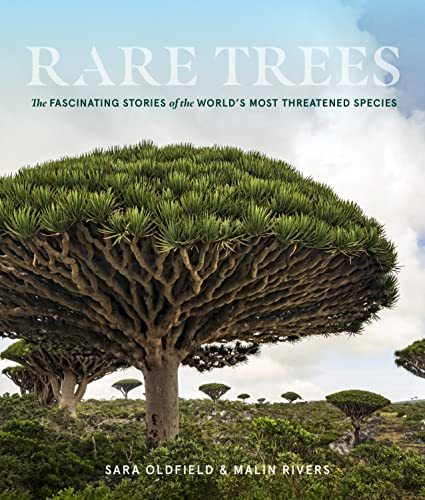
31. Rare Trees by Sara Oldfield and Malin Rivers. OK, so apparently that whole “less books about plants” pledge didn’t take. In my defense, this book is really pretty. It’s also very good; it’s about efforts for tree conservation around the world, and is published both as a public report and a fundraiser for the Global Trees Campaign. If you want to know what boots on the ground conservation work is like, its successes and its challenges, this is an excellent resource. And, like I said, the photographs are very pretty. The first chapter is about the overall history of forest conservation, and then future chapters discuss trees categorized by uses and by phylogeny. Honestly, I kind of wish they had picked one or the other of those organization schemes instead of splitting the difference, but that’s a quibble.

32. How To Survive History by Cody Cassidy. I’ve recommended some of Cassidy’s other books before (Who Ate the First Oyster? and …And Then You’re Dead), so I’m happy to report that this is his best yet. The theme is, what does science and the historical record tell us about how you could survive various catastrophes, or just hostile environments? I knew I was going to like it from the first chapter, How to Outrun a T. rex, which treats dinosaurs as just animals rather than kill crazy monsters. It also does an excellent job of summarizing Very Bad Times like the Donner Party expedition and the Magellan circumnavigation, and I learned a lot (like about how Magellan’s slave Enrique was the first person to actually circle the globe, having been captured by slavers in the Philippines and then being brought back around… and getting his revenge when he wasn’t freed as Magellan’s will proclaimed).
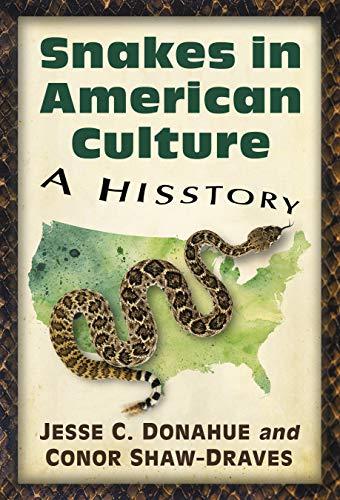
33. Snakes in American Culture: A Hisstory by Jesse C. Donahue and Conor Shaw-Draves. I didn’t expect this to be a searing indictment of the American medical profession of the early 20th century when I started the book, so that was a pleasant surprise. The first half or so is the story of how (white, upper class, male) “experts” denied that venomous snakes in the USA were really all that dangerous, while people (mostly poor, ethnic minorities and children) were dying in large numbers. Antivenin was only developed in this country as a side effect of the United Fruit Company’s desire to keep laborers from dying in the fields from snakebite, and the development of said antivenin was mostly done by volunteer labor and then marked up for tremendous profit by pharmaceutical companies! The back half, unfortunately, isn’t nearly as good, although it doesn’t go full conversion with its fairly sympathetic portrayal of snake handlers (which is something I’ve run into before). My biggest complaint is that this was written by humanities professors, and they needed a trained biologist to go over their draft. For example, they can’t format scientific names correctly, and don’t know enough about the history of science to understand that “virus” and “venom” were used interchangeably by some authors in the 19th century.
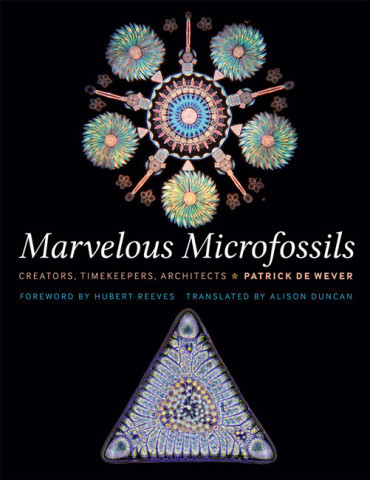
34. Marvelous Microfossils by Patrick De Wever, translated by Alison Duncan. Worst book I’ve finished this year? I think so. This book was originally written in French, but I can’t blame its problems on translation issues. It’s about plankton and other microfossils, what they can tell us about geology and how they’ve influenced art and culture. To start with the good, the book is gorgeous; each page is well organized, and it has lots of electron micrographs, photos and engravings by Ernst Haeckel. And that’s the first problem. The author seems to be a modern devotee of Haeckel’s science and philosophy, when both were full of garbage (Haeckel is the “ontogeny recapitulated phylogeny” guy, and one of the codifiers of scientific racism). His use of terminology is stuck firmly in the 19th century, and he doesn’t seem to care about modern cladistic phylogeny at all. And he has lengthy quotes from architects and philosophers instead of, you know, modern scientists, including lines specifically about how “we understand all there is to know” about plankton from like 1910. So I get huge “reject modernity, embrace tradition” vibes from this author, and that makes my skin crawl.
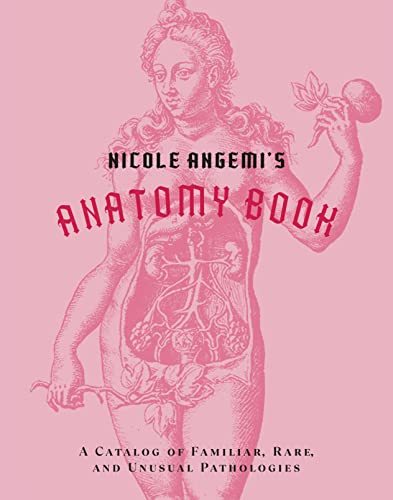
35. Nicole Angemi’s Anatomy Book by Nicole Angemi. Another “searing indictment of the American medical system”, only this one is more modern. The book is a loosely A-Z collection of pathologies, with case histories and photos. So this one is super gross, just a head’s up. Why I say it’s a searing indictment is that about 1/3 of the case studies talk about how the patient was ignored by their doctors initially, and had to spend time seeking second opinions taking them seriously, and how a number of things that could have been fixed more easily turned into huge, life altering (or ending) problems. The book is written by a pathologist’s assistant, and the introduction/biography would make a good “see, you can follow your dreams and get a career that you love later in life” inspirational story. I’m keeping a copy of this for my classroom, because I have plenty of students who are interested in medicine but not necessarily medical school, and because teenagers love gross pictures. Seriously, some of the descriptions of cysts and tumors made even my stomach turn.
#reading log#anatomy#medical history#snakes#herpetology#paleontology#plankton#botany#ecology#conservation#trees#world history
73 notes
·
View notes